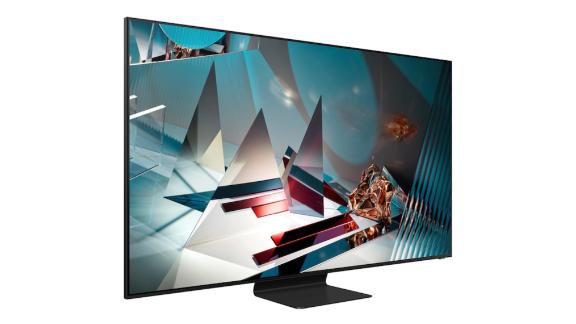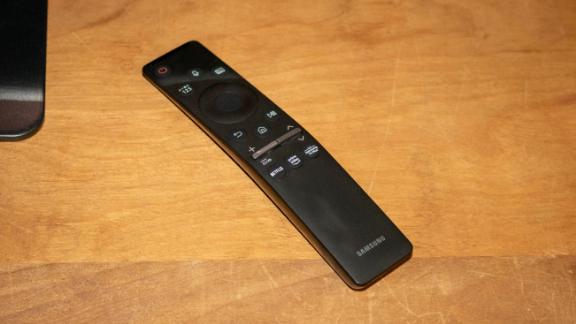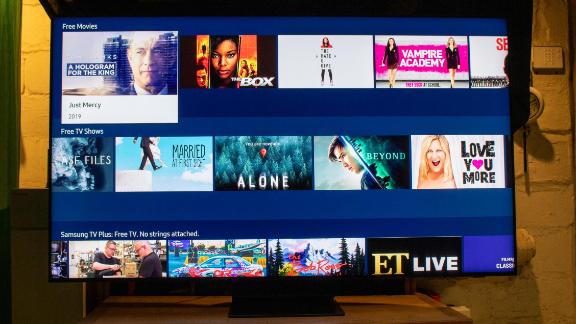These days, 4K TVs are pretty much the norm from nearly every manufacturer. But what about 8K? Samsung and Sony hit the ground running with the next generation of TVs at CES in January.
We’ve spent the past few weeks with a 65-inch Q800T QLED 8K, which has a $3,499 asking price, but is on the low end of Samsung’s 8K portfolio. It’s currently on sale for $2,999.99, but if that’s too small, it also comes in 75- and 82-inch versions.
With 8K, you get 16-times the resolution of a standard HDTV (1080p) and you can see more aspects of an image (deeper blacks and more vibrant colors), one of Samsung’s signature traits.
But with most cable shows not scratching the surface of 4K, let alone full 1080pHD, where does 8K fall in? Well, you need to dig to find the content. YouTube is definitely full of it, but the big story is similar to 4K. Samsung’s Q800T can upscale content to 8K resolution, essentially enhancing existing content to sharpen the image, increase colors and deepen blacks.
It’s really an 8K panel and processor paired with a classic Samsung QLED experience. Let’s dive into it.
Super-sleek design

Samsung’s Q800T is a looker — at 65 inches, it’s most certainly a two-person lift to handle the set up. It’s 52.9 pounds without the stand, and with the stand, it comes to 68.3 pounds.
It’s a heavy TV, but that’s to be expected. It’s also a sturdy build. The back of the TV is partially plastic molded, but there’s metal ribbing around the TV and the stand is a curved piece of metal.
It looks stunning, especially on the stand. It’s a two-piece install that took about 15 minutes for us to complete. You can also mount the Q800T with a VESA mount of Samsung’s no-gap wall mount. The Q800T is only slightly over an inch thick so it won’t stick out from the wall too much.
The bezels are quite thin around the display and allow your attention to focus squarely on the picture. The wide center stand gives it a nice level of balance, so it doesn’t feel weighted to the left or right in one way. Interestingly enough, the built-in TV controls live as a D-Pad under the Samsung logo, which is centered on the bottom.
It’s a unique spot, and we would have preferred it to live on the left or right, as you wouldn’t block the screen with changes.
The plastic back of the TV has a built-in textured area for easy cable management and feels sturdy enough. We didn’t experience any flexing, like on an OLED (Sony’s A8H or LG’s CX55). Better yet, there’s an ample amount of ports on the left side, including four HDMI ports, two USB-A ports, an ethernet, optical jack and a few others.
Six speakers face downward, along the bottom of the TV. It’s not the most solid sounding or loudest speaker setup ever seen on a TV, but we’ll dive into this later.

The Q800T has a simple and small ergonomic remote that has a subtle verticle curve to it, so you can comfortably fit it in your palm and control it with one hand. There’s a circular button setup for navigating the Tizen TV interface, dedicated volume control, mute and channel switchers. A voice control function, back, home and play round out the custom controls.
Depending on what region you’re in, you’ll get dedicated buttons for streaming services like Netflix and Amazon Prime Video. We like the design of the remote — it’s simple and functionality at its best.
Let’s talk picture quality and smarts

As expected for a Samsung, the Q800T is a QLED TV. Here’s what that means for you.
QLED is still Samsung’s answer to OLED and is an LED-backlit panel with a layer of Quantum Dots (QDs) on top. Those QDs represent the pixels and when light from the backlighting hits this layer, it creates an image. TCL uses the same premise for it’s QLED (we found its 2019 6-Series to be the Best Overall TV of 2020).
This technology is entirely different from OLED, which Sony and LG offer. Vizio will launch its first OLED models this fall.
OLED is emissive, not transmissive (with a backlight hitting a filter), The individual pixels light up when electricity flows through them. That’s why the panels are so thin on OLEDs. The pixels do the work and light up individual ones, versus QLED and LEDs, which are thicker, thanks to the backlight illuminating and creating an image through the filters.
A commonality between OLEDs and QLEDs is that the panel is only half the equation. You still need a processor to handle calibrating the panel, telling it what image to display and, of course, to enhance the picture.
For 2020, Samsung is powering the Q800T with the Quantum Processor 8K. It’s new for this year, but builds on previous TV processing units that handle calibration and image creation. It focuses on the power of AI (artificial intelligence) and machine learning, both of which will work in real time to analyze content and deliver enhancements where it can.
And in our testing, the Q800T delivers a tremendous viewing experience. Colors are vibrant and vivid, blacks are deep and the panel can get really bright. The picture, as a whole, looked pretty darn accurate and was on par with what we experienced with the Sony A8H and the LG CX55. Colors were more vibrant than the TCL 6-Series, which earned the best overall sticker from us.
The classic scene in “Captain Marvel,” where she is surrounded by a bright starburst in the depths of space, looked super bright and noticeably lighter over the OLEDs, which goes back to the backlighting technology on the Q800T. Samsung uses a Direct Full Array 24X, which gives you more lights spread around the panel to produce more accurate lighting. On an OLED, you’re left with each pixel to create brightness, but it can only do so much.
Colors seem to be slightly punched by default, but playing with the picture modes allows you to make it more realistic. Make no mistake, the Q800T offers a sharp and vibrant experience, but we slightly prefer Sony’s A8H for more accurate colors.
That being said, the Q800T beats all the other TVs we tested for top picks for brightness. Samsung’s Direct Full Array system really shines.
As a whole, content looked sharp and upscaling or watching, in general, didn’t introduce extra noise, artifacts for fuzziness onto the panel. We also tried content at a range of formats like 480p, 720p, 1080p, 4K and even 8K.
The content we tested was either streamed or directly plugged into the TV. We used a number of services that were all available natively on the Q800T: Netflix, Hulu, Apple TV+, Disney+ and YouTube, just a few.
Tizen is a great smart ecosystem, similar to webOS on LG TVs in several ways. At the bottom, you have a bar of icons that you can pull on, like a dock on macOS, and you can easily save your most-used apps as favorites. It’s easy enough to navigate and speeds for navigating the system were fast. We had one issue with trying to download apps at first, but three restarts on the Q800T fixed it for us.
Better yet, like LG and Sony you can cast content from core sources, including Apple’s AirPlay 2 standard and Google’s casting standard. You just need to be on the same Wi-Fi network to send content from your device to the big screen. It’s handy and fits in with the smart theme of the Q800T, which extends from picture quality to smart ecosystems.
Bottom line
At a full retail cost of $3,499.99, the Q800T represents the low end of Samsung’s 8K 2020 offerings. It’s not the promised truly affordable 8K panels, but it’s a sign in the right direction. For the masses, you’re better off with the more affordable panels from TCL, or even Samsung’s 4K QLED offerings.
The Q800T is still a high price to pay for 4K, and we think Sony’s A8H offers a more color-accurate viewing experience and TCL 6-Series QLED is the best option for the masses. Plus, they won’t break the bank as much.
If you’re in love with Samsung’s QLED panels, we’d recommend looking at the base 4K QLED offerings, which are more economically priced. But if you want to be an early adopter and are ready for the 8K revolution, the Q800T deserves a look.
Note: The prices above reflect the retailer’s listed price at the time of publication.
"entry" - Google News
July 22, 2020 at 12:40AM
https://ift.tt/3hnR7fP
Brilliant picture and lofty price highlight Samsung's entry 8K TV - CNN
"entry" - Google News
https://ift.tt/3f5ZAUJ
https://ift.tt/3d6LMHD
Bagikan Berita Ini














0 Response to "Brilliant picture and lofty price highlight Samsung's entry 8K TV - CNN"
Post a Comment